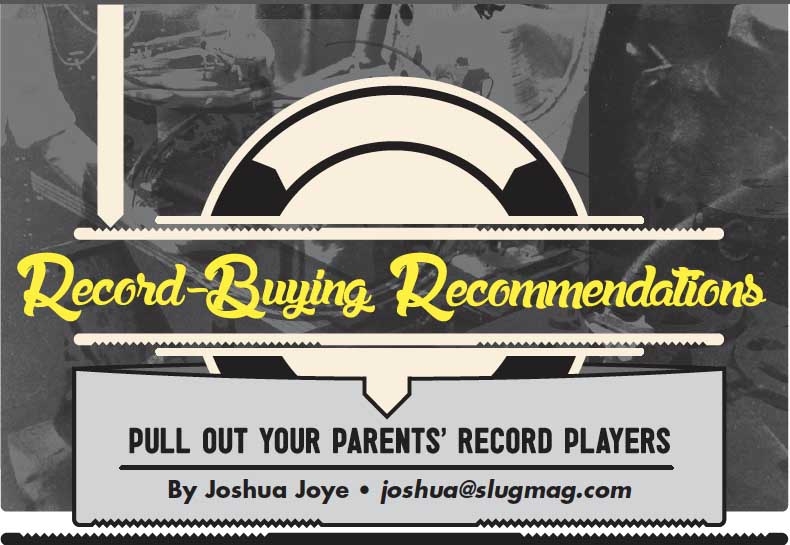Record-Buying Recommendations: Pull Out Your Parents’ Record Players
Music
A major aspect to remember when buying any vinyl record is that, in order for it to have quality sound, the music recording, mastering and pressing must contain a high-fidelity amount of precision and must be created knowing that the audio will be pressed on vinyl. True to any craft, and especially when making vinyl records with quality sound, what you put in equals what you will get out.
Buying vinyl can be fun at any level, from sifting through the bargain bin at a garage sale with friends to standing in line, waiting for a limited-edition LP, such as The Flaming Lips’ 2012 Record Store Day release, which contained contributing artists’ blood and went for $2,500. Whether you’re searching for vinyl options for yourself or for friends, SLUG wanted to offer some pointers for you to build that polyvinyl chloride collection. Read further for record price-point information and vinyl-quality specs.
Bargain Bin Vinyl:
Bargain bin vinyl records are great if you want to build a common-title collection quickly and on a budget and don’t care much about the quality of sound. Depending on the place, you can also find rare titles or records that are in good shape as long as you know what to look for, and can spot common problems with used vinyl, such as scratches.
Regularly Priced Vinyl:
When we say “regularly priced” vinyl, we are talking about sealed new pressings, repressings of popular titles and used records of near-mint to mint condition. These records are great if you start getting more into vinyl and want newer band titles of better quality than “bargain bin.”
Limited-Edition and Expensive Records:
Limited edition and expensive records can be anything from small pressings that haven’t been repressed an rare used titles, to promo or special discs, Record Store Day releases and pressings accompanied by unique artwork, among a slew of other classifications. These titles may cost you a little more than average—or a pretty penny, depending on the record. Though these are great to have in your collection, one thing to keep in mind is that your money may not be going to the sound quality of the title but, rather, for the feel, look or rarity of that high-priced record. One extra that accompanies a limited-edition or expensive record is always some kind of bragging story.
Allow this introductory list of five aspects of a vinyl record to help with all future purchases and best fit your vinyl-playing preferences.
Vinyl Record Weight
Today, records come in all variations of weight, ranging from the standard 120–125 grams up to 200-plus grams. Often, you will see 180 grams advertised on the package of newer-pressed records. Advertised or not, many new records are pressed at 180 grams. Heavier records have increased durability, while sound quality stays relatively the same as the standard 120-gram record.
Vinyl Disc Appearance
• Colored discs, along with picture discs, are produced at a higher volume than back in the day, and make for a great novelty record that looks fantastic.
• Picture discs are great if you want to display them on the wall; through the process of creating a “picture” on the disc, sound quality, is compromised due to added material in the grooves to make the image, resulting in a poor, noisy sound.
• Solid colors, clear and carbon black are all relatively the same in sound quality and are most likely the best option (preferred over picture, marble and splatter discs). The best part about this type of vinyl: Most limited-edition pressings come in these colors.
• Marble or splatter vinyl is by far the most visually pleasing—they’re mostly made of reground vinyl trimmings of first pressings. However, because of the construction of a reground, non-virgin vinyl puck used to make marble/splatter disks, the sound quality can diminish and sound noisy.
New Records
Acquiring a newly pressed record is a great option for any enthusiast looking for older repressings and releases from contemporary artists. Keep in mind that newer records that have been produced from a digital recording can sound lower in quality because of added steps between recording in a digital format and converting back to an analog format. Many new records run for about $20 to $30 for a new, unopened pressing. The upside to buying a newer record these days is that most come with a digital download code.
Artwork
Unlike with digital music, the artwork that comes on the record jacket, liner notes, extra packet or elaborate packaging are all just as important as the vinyl itself and should be considered when looking at buying new and used vinyl. A few things to look for when buying used records are split seams, hole punches, saw marks, ringwear, water damage and bent corners—among many other defects that affect the quality of the record overall.
Sizes / Speeds
Over the past decade, the two major sizes of records include, though are not limited to, 7” and 12” discs running at speeds of 45 RPM (revolutions per minute) and 33 1/3 RPM. Usually,7”s run at 45 RPM and 12”s run at 33 1/3 RPM, although companies have been pressing 12” records to run at 45 RPM to increase sound performance. Faster record speeds amount to better sound quality.

